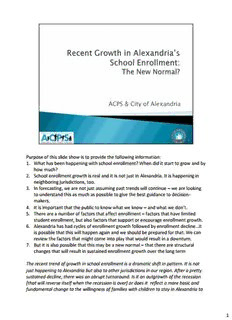
Recent Growth in Alexandria's School Enrollment: The New Normal? PDF
Preview Recent Growth in Alexandria's School Enrollment: The New Normal?
Purpose of this slide show is to provide the following information: 1. What has been happening with school enrollment? When did it start to grow and by how much? 2. School enrollment growth is real and it is not just in Alexandria. It is happening in neighboring jurisdictions, too. 3. In forecasting, we are not just assuming past trends will continue – we are looking to understand this as much as possible to give the best guidance to decision- makers. 4. It is important that the public to know what we know – and what we don’t. 5. There are a number of factors that affect enrollment – factors that have limited student enrollment, but also factors that support or encourage enrollment growth. 6. Alexandria has had cycles of enrollment growth followed by enrollment decline…it is possible that this will happen again and we should be prepared for that. We can review the factors that might come into play that would result in a downturn. 7. But it is also possible that this may be a new normal – that there are structural changes that will result in sustained enrollment growth over the long term The recent trend of growth in school enrollment is a dramatic shift in pattern. It is not just happening to Alexandria but also to other jurisdictions in our region. After a pretty sustained decline, there was an abrupt turnaround. Is it an outgrowth of the recession [that will reverse itself when the recession is over] or does it reflect a more basic and fundamental change to the willingness of families with children to stay in Alexandria to 1 raise their children and to send them to Alexandria public schools? Is this indicative of a change to a more urban vs. suburban lifestyle trend?" 1 2 3 To put the current growth in perspective, it helps to review the past decades of demographic change in Alexandria. 4 There was the baby boom in the 1950s to early 1960s, which resulted in explosive growth of population and school enrollment in the suburbs, starting with inner suburbs like Arlington and Alexandria. 1980 was another major turning point for the City. By then, many of the children born during the baby boom had left the City for college or new jobs…while at the same time, much of the new housing was multifamily, catering to young adults moving to the Washington region to start jobs. Alexandria’s household size dropped substantially by 1980 and it has remained low ever since…because of a comparatively low percentage of children in our population. This was a very dramatic demographic shift – ACPS enrollment fell by 40% from its peak – as the city became more urbanized with more single person households. That was 30 years ago. Are we seeing a new, equally dramatic shift? We are seeing evidence of a lot going on – not just some idiosyncratic variation – but the potential that something more structural is going on. 5 In Alexandria, student enrollment -- compared to the population as a whole – peaked in 1970. With the exception of a year or two, the this recent period of growth, starting in 2007 and continuing to the present -- is the reversal of a 35+ year trend. Is it just returning to the stable level of the 1990s after a disruption by the housing boom and bust of the past decade? Or is this a signal that something fundamental is changing. 6 7 This graphic dramatically illustrates several ideas: • Alexandria has a relatively low percentage of school age children compared to the United States as a whole • The number of children at each age is highest for the very youngest children and it declines thereafter -- evidence that more families leave Alexandria to raise their children than move to Alexandria to raise children. • However, between 2000 and 2010, the number of young children has increased (the number of children 0-5 grew 22%) faster than the population as a whole (9.1%). That was 2010; by now, some of those kids are already in the school system. • There is a bump in the number of older students – those are students living at Episcopal High School. • Many Alexandrians come to the City as young adults. • The earliest Baby Boomers are now older than 65. 8 The last two slides show students compared to population as a whole. It is significant that it is so low…so let’s explain why that is. Starting in 1960, Alexandria’s households sizes began to get smaller, in part due to a rapid increase in the percentage of single person households. Both trends resulted in fewer households with children. By 1980, the average household size was just over 2 persons – and it has stayed there ever since. • A major reason: City has been a gateway – primarily people coming as adults to work in the Nation’s capital • Developers met this demand by adding lots of multifamily housing (apartments and condos) to our housing stock. • Alexandria now has a very high proportion (over 60%) of multifamily housing, which is generally less attractive to families with children than single family housing units for a variety of reasons. For example, many multifamily buildings are not designed to welcome children and do not have amenities that families with children may be looking for, such as indoor or outdoor play spaces. 9
Description: